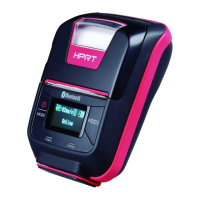HM-E200 Programming Manual
processed as normal one.
•
The
number of horizontal direction is up to nL and nH, the total number is nL + nH ×
256.
• The part which bit-image is beyond the current area will be amputated.
• d indicates the bit image data. Set a bit to 1 to print a dot, or set a bit to 0 to not print a
dot.
• After the bit-image is sent successfully, the printer will be back to the normal data
processing mode.
• If the width printing area set by GSL and GSW lee than the printing width of GS /
required by the data sent with the ESC* command, the following will be performed
on the line in question (but the printing cannot exceed the maximum printable area):
① The width of the printing area is extended to the right to accommodate the amount
of data.
② If step ¬ does not provide sufficient width for the data, the left margin is reduced to
accommodate the data. For each bit of data in single-density mode (m = 0, 32), the
printer prints two dots: for each bit of data in double-density mode (m = 1, 33), the
printer prints one dot. This must be considered in calculating the amount of data
that can be printed in one line.
• It back to the normal data processing mode after printing a bit-image.
• This command won't be influenced by other print modes (emphasized /double-strike
/underline /characters amplification /white / black reverse), except upside-down printing
mode.
• the relationship between data and the point to be print as follows:
Choosing
8-dot density:
Choosing 24-dot density:

